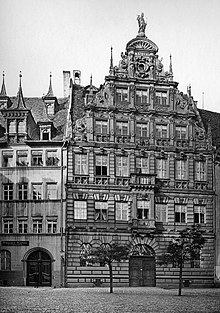Community center
In art history, a town house is understood to be the often representative home of a city citizen. The term is only used for historical houses in a condensed, usually old-town environment and can thus be distinguished from the villa .
More recently, the term has also been used for public event buildings supported by the city , which are also called community center or town hall .
Plant and characteristics
The medieval town house was the residence of the legally fully valid residents of a city ( citizens ), mostly in connection with the commercial premises for trade or craft. The design is very different, but very similar for a region and time epoch, at least in one city, as all the plots of the founding cities were evenly parceled out. The town houses bordered with the facade directly on the roadside and were mostly built without gaps, or only with very narrow gaps. If the facade showed the gable , then one speaks of gable-side, otherwise of eaves-side town houses. The commercial rooms were on the ground floor, the living rooms on the upper floor and the roof served as storage space. In the Lower German town hall, the hall on the ground floor was usually the largest room that could serve as a living room , workshop and sales room at the same time . There was often an open fireplace at the end of the hall.
If the property is only accessible from one side, a passage led through the house into the courtyard behind the house, in which there were often other outbuildings.
Historical development
The development of the community center in Central Europe is closely related to the rise of cities in the 12th century and the resulting self-confidence and the will to represent the bourgeoisie. The wedding of the town house thus includes the style epochs of the Romanesque , Gothic , Renaissance and Baroque periods . The loss of the independence of the Central European cities, the rise of the territorial states, the economic changes and the strong population increase also led to a transformation and ultimately to a loss of importance of the community center in the late 18th and 19th centuries. Nevertheless, upscale urban residential buildings continued to emerge, now in the style of Classicism , Historicism and Art Nouveau , which, if they were built in a dense residential area, are referred to as town houses in the broader sense. Bourgeois living, however, increasingly shifted to detached villas, while the type of tenement became characteristic of the dense construction in cities .
National
Existence and reconstruction efforts in Germany

While town houses in central European cities outside Germany (e.g. Prague , Riga , Krakow , Bruges , Basel , Strasbourg ) still make up an important part of inner-city secular buildings, they are in Germany due to the massive losses caused by the Second World War and subsequent demolitions become rare in big cities. The losses also include many first-rate buildings, such as the Pellerhaus and the Toplerhaus in Nuremberg . However, there are still a large number of town houses in small towns and in the few larger cities in Germany that, like Görlitz or Regensburg, have been largely spared from destruction and demolition.
A few town houses in Germany were also rebuilt, such as the Goethe House and the row of houses on the Saturday Mountain in Frankfurt am Main and several simplified reconstructed houses on the Prinzipalmarkt in Münster . There are currently further efforts to reconstruct ensembles of town houses more or less true to the original , e.g. B. at Neumarkt in Dresden and between Römer and Dom in Frankfurt am Main . The inner courtyard of the Pellerhaus in Nuremberg is also being reconstructed and can later be supplemented by the Renaissance facade.
See also
Web links
literature
- Hans-Günther Griep: Small art history of the German town house. [1985], 2nd edition, Wissenschaftliche Buchgesellschaft, Darmstadt 1992.
- Adolf Bernt: Bürgerhaus in: Reallexikon zur Deutschen Kunstgeschichte , Vol. 3, 1951, Sp. 180–221.
- The community center. Living and Working (Preservation of Monuments in Lower Austria Volume 60; Communications from Lower Austria No. 3/2019). Ed. Office of the Lower Austrian State Government Department of Art and Culture St. Pölten, Berger Printing Company, Horn o. J.
